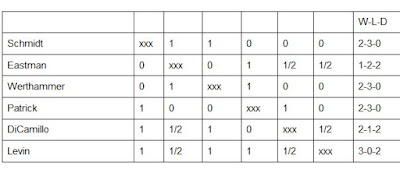The championship situation starting in 1944 up to about 1954 saw considerable changes. At the end of World War Two several of the top players were either in the military or working for a living and had little time for chess. The young players of a decade earlier were reaching middle age and many had lost interest in chess. The result was the championships of those years, which usually had only one or two GM strength players, were among the weakest held since the 1870s.
Samuel Reshevsky was studying for his CPA exams and passed up the 1944 tournament, Fine played in 1944, but retired after he failed to win. Kashdan played in 1946 and 1948, failed to win, and gave up on his quest for the title. Arthur Dake had given up competitive play in 1938 and rarely played.
Alexander Kevitz, who in the mid-1930s was considered a promising talent, was discouraged by his even score in the 1936 tournament and gave up chess to concentrate on his pharmacy business. Arnold Denker, who won the 1944 championship, played infrequently after 1946 in order concentrate on his business career. Members of the 1950s crop of players, Larry Evans, Arthur Bisguier, George Kramer, and Robert and Donald Byrne were just entering the master ranks.
One example of the strength of the championship tournaments of the period was the 1944 event. Louis Persinger, a violin teacher and a member of the Juilliard School of Music faculty, only scored a single draw and lost 16 games.
The 1946 tournament showed things returning somewhat to normal and it also had a big controversy involving the United States Chess Federation. USCF officials realized that the championship was no longer attracting the strongest players. Besides the aftermath of the War and the necessity of the top players earning a living, they believed the championship had long been dominated by New York area players and many players from outside the NY area were being left out.
To remedy the situation, the USCF announced there would be no seeded players for the 1946 championship and anybody who wanted to play, including GMs, had to compete in regional elimination events. The fly in the ointment was that the plan did not take into consideration that talent wasn't evenly distributed around the country. For example, Herman Steiner and Arthur Dake lived on the West coast, but Reuben Fine had moved there. Since only two players from the West coast could qualify, if all three of them decided to play, one of them wouldn't make the cut. New York was allowed three spots. At the time Isaac Kashdan, Al Horowitz and Albert Pinkus were considered the big guns, so if they decided to play, promising players like Alex Kevitz, Herbert Seidman, Anthony Santasiere and a promising 16-year-old named George Kramer would likely be out.
In an attempt to correct the problem this new system created, Edward Lasker announced the formation of a new group called the Association of American Chess Masters. He was the president, Fine, Reshevsky and Pinkus were vice presidents. The AACM, not the USCF, organized the 1946 championship with regional events to choose some of the qualifiers, but there would also be seven seeded players.
The Area 3 qualifiers were Jacob Levin and Atillio DiCamillo while George Eastman and Dr. Siegfried Werthammer qualified for the Master’s Reserve Tournament to be played at the same time. Results of qualifier were:
In the championship, Levin scored very well. His score of +9 -2 =7 was good enough for a clear fourth place. His two losses proved critical. The top finishers were Reshevsky (16 out of 18), Kashdan (13.5) and Santasiere (13). If Levin had managed to defeat Sanatsiere, he would have tied Kashdan for second place. He also lost to DiCamillo who was mired in the middle of the table in places 13 to 16 with 6.5. A win against DiCamillo would also have put him in a tie for second.
I was unable to find anything on Malcolm Patrick whom I believe lived in Elyria, Ohio. Dr. Siegfried Werthammer was born in Austria on January 11, 1911 and won or tied for first in the West Virginia championship a dozen times between the years of 1943 and 1965. Dr. Werthammer was chairman of the Pathology Department of Marshall University, serving in that post from 1975 until his retirement in 1978 at which time he became clinical professor emeritus. He also was chief pathologist at St. Mary's Hospital from 1942 until 1961 and at Cabell Huntington Hospital from 1955 to 1979. He died Jan. 1, 1983 in Sarasota, Florida.



Malcolm Patrick is listed as a resident of Lakewood, OH on the early membership lists of the Ohio Chess Association. In the first State Championship in 1945, he and Milton Q. Ellenby of Dayton tallied 5 wins, 0 losses, 2 draws, but Ellenby was awarded the title on tiebreaks.
ReplyDeletePatrick played on the Class A team for Cleveland in a city match versus Akron on May 16, 1948, scoring 1 point. Cleveland dominated the match, 11 1/2 - 4 1/2.
Thanks. I discovered a Malcolm Patrick, age 23, in the 1940 census that lived in Elyria; may not have been the same person.
ReplyDelete